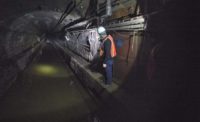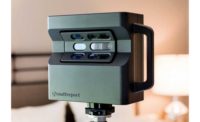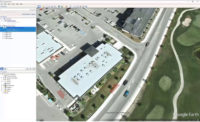With a sprawling network of tunnels in need of repairs and upgrades, the New York Metropolitan Transportation Authority has explored in recent years how it might automate some of its dirtiest and most time-consuming underground work. Now, after a successful trial of a railcar-mounted robot to drill holes for tunnel cable racks, the MTA is putting together an open bidding process for vendors to further develop a robot drill rig for use in New York City’s subway tunnels.
“The advantage is in maximizing the rate of productivity,” explains Alaadien Waziry, robotics project lead at the MTA’s Construction & Development division, which manages its capital projects. “[It’s] much more productive than the manual drilling performed by the contractors in the tunnels.” Waziry presented the MTA’s findings on the drilling robot’s performance at the 2021 ENR FutureTech conference, held online June 9 to 11.
Back in 2017, a team led by Bechtel won the MTA’s Genius Challenge with a proof-of-concept design for a railcar-mounted drilling robot. It was based on a similar robot used by the contractor on the U.K.’s Crossrail project. After the competition, Bechtel teamed up with New Brunswick, N.J.-based robotics firm Reliabotics to develop a working prototype of the tunnel-drilling robot.
The rig consists of a six-axis industrial robotic arm with two Hilti drills attached. Once positioned, the robot operates autonomously, sensing the tunnel wall surface and finding the optimal locations to drill anchor holes. Its sensors can detect obstacles and avoid drilling into any weak areas of the concrete tunnel liner. An adjacent control car houses a 400VAC generator, an air compressor and vacuum system. The vacuum captures silica dust during drilling, thus eliminating a major safety hazard to workers on this type of job, notes Waziry.
A successful field test in 2019 led to further development of the robotic drill rig, which was then used in December 2020 during rehabilitation of the New York City subway’s Rutgers Tunnel. It carries the F train line beneath the East River. Cable trays had to be mounted high on the tunnel walls, and the precision of the robotic drill sped up the process. Once it got going, Waziry says the productivity was impressive. “The manual productivity [for this task] amounted to about 100 linear feet per hour,” he says. “Using this pilot robot, we were able to achieve more than 300 linear feet per hour.”
The robot was used on a limited basis in the Rutgers Tunnel project, and Waziry already has grander ambitions for the system. He envisions a pair of robotic arms on a railcar acting in tandem with a total of 12 drills between them, not only drilling out the holes in the tunnel walls but also installing the anchors and equipment. “We’re hoping this [approach] will improve productivity to about 800 linear feet per hour,” he says.
The MTA is currently working on an open bidding process for the next robot, rather than just offering the job to Bechtel and Reliabotics. “We are going to maximize the competition and allow other vendors to bid on the work,” Waziry says. And how does all this automation affect the labor used to perform the work? “At this stage, we are envisioning the robots will be used by the vendors who develop them,” Waziry says. But as the systems mature, the barrier to entry lowers. “In the future, we anticipate that we’ll be able to train our own staff in utilizing them, in conjunction with contractors.







Post a comment to this article
Report Abusive Comment